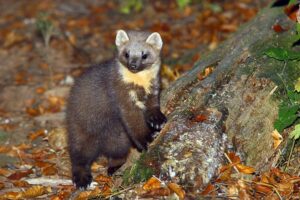The marten (Martes americana), often called the pine marten, is a member of the weasel family. This family (Mustelidae) of small specialized predators had its origin in the Old World, but has spread until it is now found almost around the world. The marten entered North America from Asia in the early Wisconsin period of the Pleistocene Epoch, some sixty thousand years ago. The marten has a long slender body, small head with large round ears, dark brown eyes, a short pointed muzzle, and a bushy tail about half as long as the body. An adult marten is about the size of a small house cat. Males average about 16 to 17 inches and weigh up to two and one-half pounds and females are a bit smaller. Legs are short, but the feet are large and furred. The hairy pads may help the marten grip when climbing. The marten is the only mustelid to routinely climb trees and can be found in Alaskas woodland habitats from Southeast to the farthest north limit of trees in the Arctic. However, the greatest number of them live in the mixed-wood forests and bogs of the Interior. Like squirrels, martens can reverse their hind feet and come down trees headfirst (the hind legs pivot at the hips).
While the marten spends much time in trees, it probably catches most of its food on the ground. They are effective predators, but they are also opportunistic, and along with their usual diet of voles, squirrels and mice they also eat carrion, berries and eggs. During the berry season, they consume enough blueberries to turn their lips and scat blue! The marten is considered nocturnal, though it is often active in the day. Generally, marten are solitary except in the mating season which is in July and August but the young are not born until nine months later. The long gestation period for an animal this small, is due to the delayed implantation of the fertilized egg to the uterus. (All members of this family have this breeding phenomenon). A litter of three or four young is born the following March or April. A tree cavity is the usual denning site for the marten. At three to five months the young reach adult size and leave the den to take up their solitary existence. The young normally mate for the first time when they are two years old, therefore, young female marten do not bear young until the third year of life. Typically, they can live up to ten years in the wild.
In winters with adequate snowfall, you can find marten tracks in the forest. When hunting on the ground the animals move about a great deal, crossing and criss-crossing their own tracks. They will travel considerable distances beneath the snow to check out deadfalls and other promising food areas. Also during this season, the soles of the martens feet are heavily covered with hair, and the toes are not distinguishable in the tracks. In late winter and until fall, toes can be seen in tracks on hard snow or hard sand. The tracks are about one and one-half inches long with ermine tracks being much smaller and wolverine tracks much larger.
The marten has also been called the American sable and its pelt can bring a high price for its beautiful dark fur. Most marten are brown with a creamy yellow or orange patch on the chest and neck. In the early 1900s over trapping occurred because of the high price for the pelts and because marten are curious, they were easy to trap. Habitat loss, primarily by logging and human settlement have caused declining populations in many areas of their southern range but most biologists feel they are in healthy numbers here in Interior Alaska.




